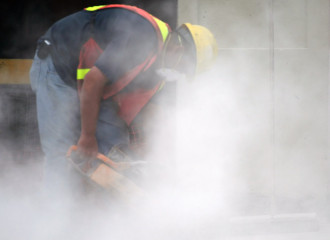The Next Asbestos?
Back to blogSilica Dust: The Next Asbestos?
Pretty much every construction activity you can think of generates dust – cutting, drilling, grinding, sanding, breaking – you get the idea.

Dust is a perfect nuisance, but more than that, it is actually a lot nastier than it may seem, killing thousands a year and ruining the quality of life of many more.
Whilst silica dust (from anything with sand in it) is the worst offender, wood dust and dust from other building materials, such as the gypsum in plasterboard, are also highly hazardous.
In fact, dust could potentially be a worse threat than asbestos. Asbestos has earned respect. If someone encounters asbestos, they know the dangers and don’t mess. Dust, instead, is so common and widespread that it isn’t seen as a danger. But it sits alongside arsenic, exhaust fumes and asbestos in the list of Group 1 Carcinogens, substances known to cause cancer.
So how to control it?
- HSE favours prevention over cure – planning to reduce dust on site, for example by buying in materials to size that require less cutting and machining.
- Next best is to remove the dust at source, primarily using on-tool extraction (for which the technical term is Local Exhaust Ventilation, LEV). A connected vacuum can lead to 90% less exposure, catching most of the dust before it has chance to fill the air.
- The last line of protection is dust masks (officially Respiratory Protective Equipment, RPE), which have ‘APF’ ratings – APF 20 is the typical standard for construction dust.
Talking vacuums, for any construction process producing dust, the minimum standard is ‘M class’, which means a medium level of protection. M class vacs filter at least 99.99% of dust, enough to meet regulations.
If a vacuum cleaner is rated ‘M class’ it will usually be clearly stated. If unsure, ask the seller.
Standard site vacuums, such as ‘Henry hoovers’, aren’t rated and won’t filter enough dust to meet regulations. Increasingly sites are adopting M class vacuums as standard. If your site hasn’t yet adopted them, it’s sure to be coming soon.
M class or H class?
There is some uncertainty over whether M class or H class vacuums are required for construction. An M class filters enough dust to meet regulations. However, the official EN standard states when dusts are carcinogenic (as silica and wood dusts are), H class vacuums are required. HSE have produced a report, aiming to clarify the situation, concluding that ‘maintaining an adequate flow rate is easier with a class M vacuum cleaner’. For dusts containing silica, they say ‘a minimum of a class M vacuum cleaner should be used’. Essentially, an M class is your best option.
Useful links:
HSE CIS36 – Construction Dust Information Sheet (clear and easy to understand)
CITB The Construction Dust Partnership (website giving a lot of good resources and information on the dangers of dust)
HSE ‘On-tool controls to reduce exposure to respirable dusts in the construction industry’ (fairly in-depth, if you are really wanting to get into it!)
